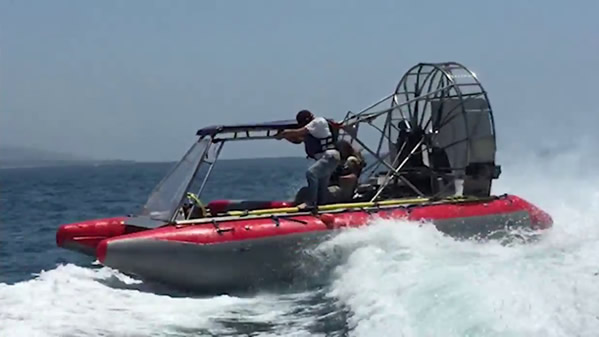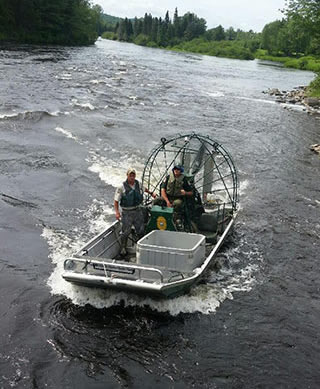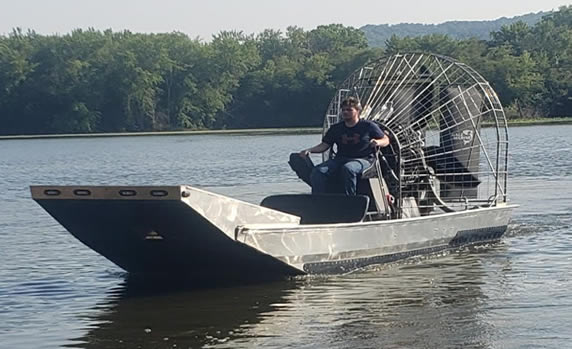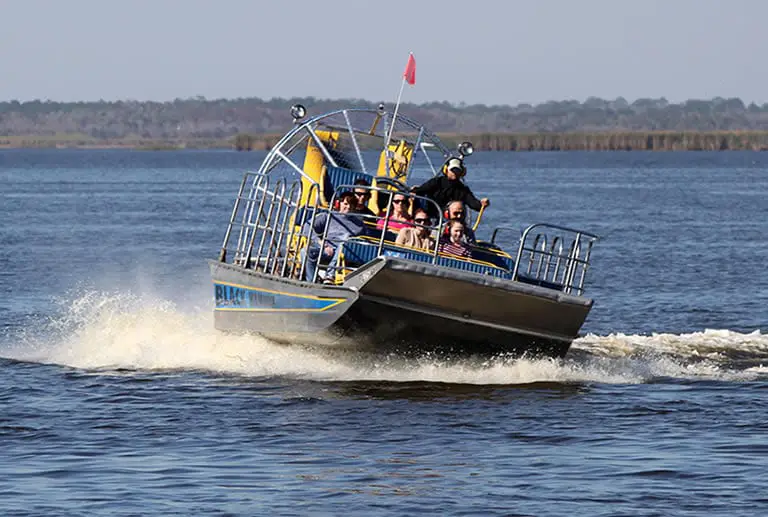Can Airboats Go In Deep Water?
An airboat can be used in deep water.
Although it has a flat bottom hull and a shallow draft it is more than capable of being used in very deep water.
However, as some deep waters may also be open waters precautions should be taken if those bodies of water experience a lot of wind and chop.
Turning is the main concern in deep water.

The airboat should be kept on plane and turns should be taken slowly to avoid taking on water.
Wash from other vessels can also be a problem.
Running Deep: How To Safely Use An Airboat In Deep Water
Running deep in an airboat is not just possible but it is done often.
However, there is a difference between operating an airboat in the shallows and operating it in deep water.
If you intend to take your airboat into deeper water there are some things you need to be aware of.
You must be much more vigilant and careful when using an airboat in deep waters. This is because the flat bottom and shallow draft of the boat means it is more susceptible to taking on water.
Also, the Jon boat type shape of the hull means it is not as capable of deflecting splash as well as other vessels.
Weather conditions and deep water use
Deep water reacts differently to wind than shallow water. We all know this.
So it stands to reason that using an airboat in deep water is only advisable if the conditions are optimal.
Of course not all deep waters are choppy but many of them are.
Inland lakes can be quite deep but many are also fairly protected from strong winds due to the environment in which they sit.
For the most part deep only really becomes problematic for flat bottom boats when it becomes choppy.
Though airboats are slightly different as they also have to deal with wash.
If you plan to use an airboat in calm lakes then the weather will be less of a concern.
However, if the lake has larges areas of open water then the likelihood is that it will experience a fair degree of chop and maybe even turbulent waters at times.
Airboats are not designed to be used in rough water.

The hull design basically resembles a big a mod-v Jon boat that has a heavy fan at the back.
This is not a good recipe for rough water use.
So, if you intend to run an airboat deep just be sure the weather will not affect the boating conditions and make the water too choppy to boat in safety.
As most airboat owners are too wise to take to deep water in challenging conditions, the biggest problems they encountered when they run deep happens when taking turns.
Taking turns is the biggest problem
An airboat is designed for speed. But, it is designed for speed in shallow water.
If you take a turn or make a maneuver at speed in deep water you are likely to run into trouble.
The key is to position your boat correctly and then take the turn slowly to avoid taking on water.
To do this you need to get on plane well before you make any maneuvers.
The best way to protect your airboat from taking on water is to get it up on plane as quickly as possible.
When the boat gets up on plane it is much less likely to experience any wash coming over the stern quarter as you make a turn.
Once up on plane take the turn more slower than you would in shallow water as this will also reduce the likelihood of taking on water.
Never try to turn in deep water from a dead stop. Get the airboat up on plane first.
Getting on plane
The best way to get on plane, if you can, is to start in 2 – 3 feet of water. Get on plane quickly and then venture into the deeper areas.
Test your ability to stay on plane while taking turns slower than you normally would.
Remember, it makes no difference how deep the water is if you are on top of it!
Staying on plane is your best defense against taking on water.
Be aware that you should also try to avoid coming down off plane as you are turning. In the wrong conditions you can be swamped by your own wake!
The wake of other vessels
Taking turns is not your only concern. In deep water the wake of other vessels is something to be wary of as well.
Most flat bottom boats have trouble with wake but as they are used in shallow water it is usually less of a problem.
Out in deep water you are much more likely to encounter other, and larger, vessels.
Even pontoon boats have trouble with wake and they are designed for large lake use.
Probably the safest way to take on wake from other vessels is to hit it straight on, bow first.
Stopping in deep water
Unlike stopping an airboat in the shallows, you need to do it slowly when in deep water.
Always start to stop long before you think you need to.
Stopping abruptly in deep water will cause wash to cover your boat.
Gradually decrease your speed giving yourself plenty of time to get to a dead stop.
Safety tips for using an airboat in deep water
Below are some key safety tips to follow if you intend to take to deep water in your flat-bottomed, shallow draft airboat.

Stay safe, follow the guidance I have given in this article and you will be able to run as deep as you like.
Weight distribution is important
Weight distribution is vitally important when taking an airboat to deep water.
It is actually important all the time but even more so in bodies of water where you could lose your boat.
Keep the weight on your boat well balanced and well within the weight limit capacity of your particular vessel.
Personal safety is essential
When it deep water always wear a PFD.
Airboat users tend to think they are safe from drowning because they play in the shallows and this is a habit that is difficult to break.
But, when you intend to run deep make sure to have something on that will keep you afloat should your boat go down.
A good PFD is not that expensive and it is an investment you may live to be thankful for the rest of your life.
Do this if the airboat takes on water
If your airboat starts to take on water there isn’t a lot you can do at the point except to hit the gas and head for safety. Power up the motor and take flight – unless of course you are going in nose first.
Aim the boat at the shallowest water you know of and get it on solid ground as quickly as you can so you can bail out the water.

